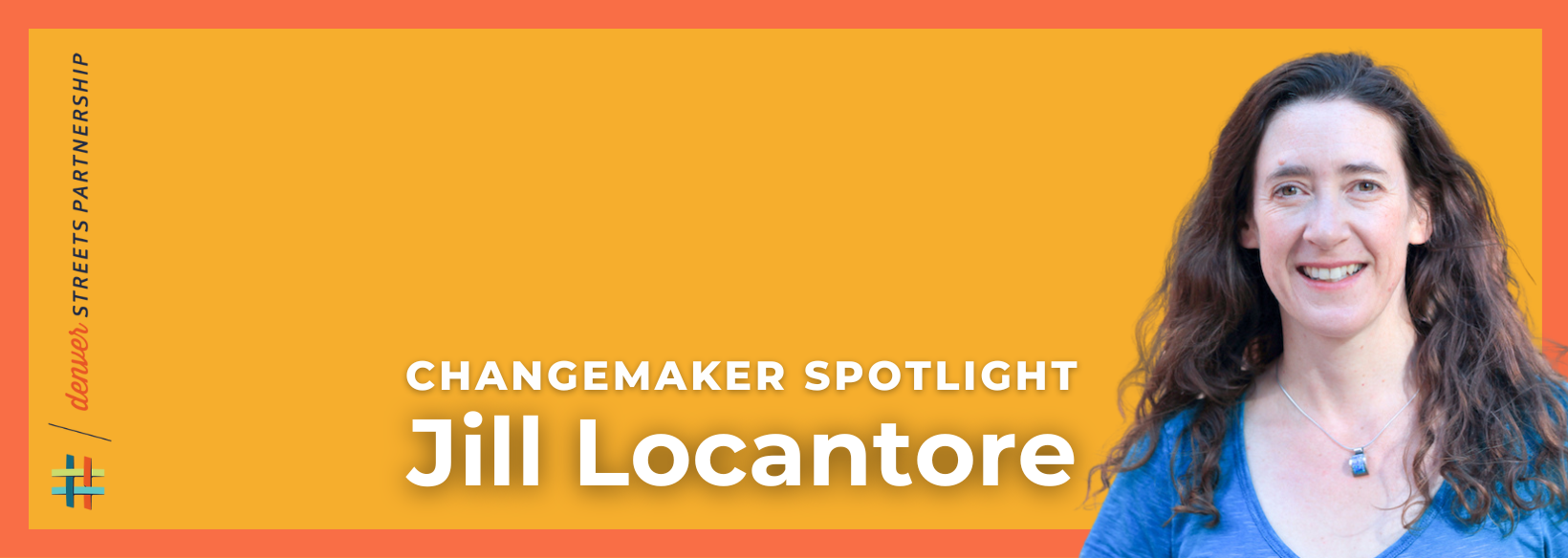
Changemaker Spotlight Series – Jill Locantore, Denver Streets Partnership
Welcome to Strat Labs’ Changemaker Spotlight Series! This blog series is dedicated to showcasing the inspiring journeys of remarkable individuals who have transformed their passions into purposeful endeavors, leaving a significant impact on the world around them every single day. Join us as we delve into the heart of innovation and commitment, celebrating the extraordinary stories of those who are not just dreaming of a better future but actively shaping it in their journey as a changemaker.
Jill Locantore is Executive Director for the Denver Streets Partnership, a grassroots organization that advocates for the cultural and systemic changes necessary to reduce Denver’s unsustainable dependence on cars and to design communities that put people first. Previously, Jill was the Executive Director of the pedestrian advocacy organization WalkDenver (merged with Bicycle Colorado) and also worked for the Denver Regional Council of Governments (DRCOG) and the Metropolitan Washington Council of Governments, where she supported regional efforts to coordinate land use and transportation planning.
Throughout her career, Jill has focused on the intersection of land use and transportation with environmental sustainability, economic development, public health, and social justice issues, and has built a reputation as an important advocate and spokesperson for human-centered transportation and its key role in building healthy communities.
What inspired you to embark on your journey in the social impact space?
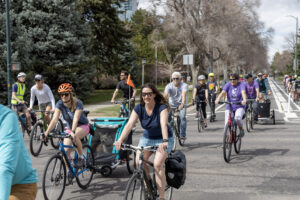
It’s truly my lived experiences that have inspired me. I grew up in Colorado Springs, in a very car-centric community. There was very little transit service available when I was growing up.
When I moved to Toronto for graduate school, I couldn’t afford a car on such a little income while paying off student loans. I knew that Toronto had a good transit system, so I decided to give it a go and see if I could survive in the city without owning a car.
I quickly learned that Toronto has a fantastic transit system! It has great walkable neighborhoods and an incredible network of green spaces that connect the neighborhoods. You can walk through park-like conditions to get where you need to go every day, and I realized that did not happen by accident. There were policy decisions made that were very different in Colorado Springs, where I grew up, versus Toronto. I started thinking, ‘How could I be part of that to make cities more livable for people, and particularly people like me who have a low income? How can we make our communities accessible, where everybody can thrive, regardless of who you are?’
I initially started in the government side. I got a degree in Urban Planning and worked for a few different government agencies, but was frustrated by how car-dominant a lot of government planning still is. So, I eventually ended up on the advocacy side to try and shift our planning to be more oriented around people and less about cars.
Can you describe how you and/or your organization are making a significant social impact?
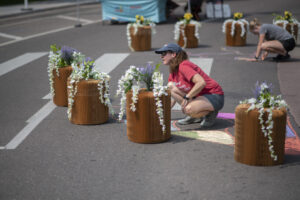
Part of what drew me to transportation, specifically within urban planning, is that it intersects with many aspects of our lives. First, in terms of affordability, owning a car is usually the second most expensive cost for a household. The money that you’re spending on your car and gas is money that you don’t have available for other things.
Next, in terms of accessibility, if you’re an individual with a disability, an older adult who no longer feels comfortable driving, or a child who doesn’t have a driver’s license, your ability to engage in the community is really limited. Therefore, people in these categories are somewhat treated like second-class citizens who don’t deserve the same access as everybody else.
Third, transportation affects our environment and air quality as one of the biggest contributors to pollution and greenhouse gas emissions.
Lastly, transportation is one of the biggest contributors to preventable death in terms of traffic crashes. In terms of top causes of death, traffic fatalities are up there with gun violence and drug overdoses, but we actually have control over this issue and could be preventing them.
There are so many ways that transportation affects our quality of life, and we’ve sacrificed so much of that quality for the sake of the speed and convenience of driving. At Denver Streets Partnership, we’re trying to recenter people in the way we think about our transportation system and the design of our communities, and focus on prioritizing human dignity so everybody can thrive in our community.
Can you tell us about a project or initiative you’re particularly proud of and its impact on the community or issue it addresses?
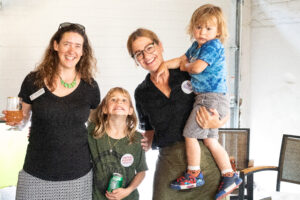
One of our longest-running campaigns in Denver is focused on sidewalks. Similar to a lot of Western cities, Denver has left the construction and maintenance of sidewalks entirely up to adjacent private property owners. Unfortunately, this means that Denver has an atrociously bad sidewalk system, where 40% of our streets have no sidewalks at all or sidewalks that are too slim for a person in a wheelchair or a parent with a stroller. This makes it unsafe for anyone trying to walk, ride, or push to get around. Every year, we have 20 to 30 people killed while walking on Denver city streets. while walking on Denver city streets. We’ve been working on this issue since 2015, asking the city to take over responsibility for sidewalks, just like they do for other basic infrastructure. We believe they should establish a dedicated funding source for that purpose because sidewalks aren’t free.
We eventually decided to take this issue directly to the voters because in Colorado, you can create citizen-initiated ballot measures. We asked the voters if they think sidewalks should be a priority and if they would be willing to help by paying a property fee to help build out and maintain our sidewalk network.
The voters approved this in 2022 and now we’ve been working with the city on the details of how that program actually gets implemented. If all goes well, the city will start collecting the fees this July, which means they could get started sometime in the near future with building and maintaining sidewalks.
What are some of the biggest challenges you’ve encountered while pursuing your purpose, and how have you overcome them?

One of our biggest challenges is that automobiles are so deeply embedded in our culture. It’s been glorified through advertising, movies, and the news media for many decades. There’s even a term that psychologists have come up with called “motonormativity,” which is the assumption that cars are so essential to our lives that it’s worth sacrificing other things.
Our challenge is how to help people recognize their own blindness to the harm that cars have imposed on us and think about how our cities could be different if we weren’t so dependent on cars. We’ve only known cities to function in one way, so it’s hard for people to imagine how it could be different. An important aspect of Denver Streets Partnership’s work is doing demonstration projects to help people re-imagine how our streets or neighborhoods could function differently if it weren’t so car-centric.
In your opinion, what are some emerging trends or innovations in your industry that have the potential to drive significant change?
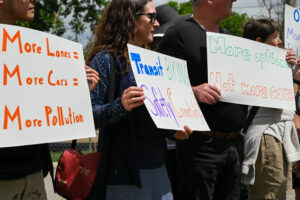
I definitely think the culture is changing a lot. One of the biggest innovations that’s driving that change is the increasing availability of electric bikes. Denver pioneered a program that’s been replicated across the country that provides subsidies for residents to purchase e-bikes. This encourages them to do so, and it can be eye-opening for people to discover the range of things you can do with an e-bike that goes well beyond a regular bike. You can haul groceries, go longer distances, or ride on a hot day without overheating. It becomes a much more viable replacement for a car and often results in people giving up their cars in favor of using an e-bike.
How do you define “Changemaker”? Can you explain what you mean or give an example?
A changemaker is a special type of person who has a vision for how things could be better or comes up with creative solutions to problems rather than just pointing out the problems. It is someone who puts in the work to figure out how to solve the problems and has a vision of a future state that would be better than what we have today.
What advice would you give to someone looking to start their own journey as a changemaker within the social impact space?

I would advise them to make friends! There’s real power in bringing together a community of people who want to make change rather than trying to do it as an individual. It’s through collective action that change actually happens. Find other people who share your interests and your vision. Doing it together makes it more fun and makes it easier to deal with the inevitable setbacks that you’re going to face.
Also, you have to be patient and persistent. Change takes time. None of us has a magic wand that can make things happen overnight. There will be incremental wins and setbacks. You have to roll with the setbacks and celebrate those small incremental wins, but keep your eye on the prize and just be persistent. If you’re patient, it can pay off.
Looking ahead, what are your aspirations and goals for the future of your work, and how do you plan to continue your journey as a changemaker?
I’m hoping to work myself out of a job. Partly because I’m hoping to actually solve some problems in my lifetime. It would be lovely if we had a complete sidewalk network in Denver before I die. But also, it’s not just about me; it’s about the community. I want to see more and more people taking on this cause of reducing our dependence on cars and refocusing on people as the priority in our communities. It’s definitely happening—I’m not the sole voice—there are other people showing up at community meetings, talking to the media, reaching out to their elected representatives, and painting a picture of what Denver could look like in a future that’s less car-centric.
Can you tell us a story about a particular individual who was impacted or helped by your cause?
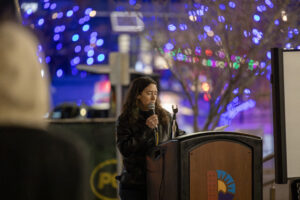
One of the hardest parts of my work, and the most motivating, are all the people who have been killed in traffic crashes and all of the families that are impacted by that. They are the victims who have been sacrificed to this car-centric transportation system where we’ve said driving is more important than the safety and well-being of our community members. That’s what gives our work so much weight and meaning. We can take a tragedy and turn it into actual meaningful change in our community.
There’s an example of a bicyclist—a young mother named Alexis Bounds—who was hit and killed while biking in Denver’s Washington Park neighborhood. There was huge community opposition to adding a bike lane to the street where she was hit and killed. It was both tragic but incredibly heartwarming to see how much the community rallied around Alexis and her family to show their support and demand that the city make the street safer. Now, that street has one of the best-protected bike facilities in the entire city. That is exactly why we do this work: to save future lives. Those people don’t necessarily know that their lives were saved, but we have the memory of Alexis Bounds to underscore how important that work is.
How do you approach collaboration and partnerships in the social impact sector, and what role do they play in achieving your goals?
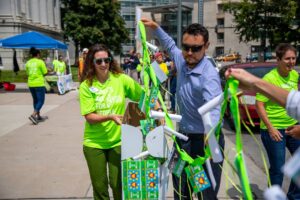
Transportation intersects many aspects of our lives, so we have sought out a coalition of partners who care about transportation for all those different reasons. We partner with environmental groups who are concerned about the emissions from automobiles, groups that advocate for accessibility for people with disabilities, or groups that are focused on making our communities equitable for people of all income levels. We bring these groups together to speak with a unified voice regarding the specific policy changes or investments that we’re advocating for.
I think that collaboration has been critical to our success. We’re not a single-issue group. We can achieve so many different wins by tackling this one core problem— our dependency on cars—together.
To learn more about the impactful and important work that Denver Streets Partnership is doing, visit their website at denverstreetspartnership.org.
If you are interested in connecting with Jill Locantore to learn more about her changemaker journey, you can contact her at jill@denverstreetspartnership.org or connect with her on LinkedIn.